High-Altitude Balloon

In the Spring of 2015, I and two first-year physics majors, Graham Rich and Max Maurer, participated in a high-altitude balloon project with the Python Piedmont Triad Users Group (PYPTUG). The project, led by PYPTUG organizer Francois Dion, and named “Team Near Space Circus” was supported by contributions from Inmar, Dion Research, and the High Point University Department of Physics.

The full payload consisted of 7 Raspberry Pi single-board computers (networked together), 7 Pi cameras, one PiNoir infrared camera, two sensor arrays to collect data, an APRS radio transmitter, a SPOT GPS tracker, and two 3s 4000mAh lipo batteries with UBECs to step the voltage down to 5 V so as to be compatible with the Raspberry Pis. More details about the payload and the network can be found here on Francois Dion’s blog. All of these components were nestled inside of a hollow Styrofoam sphere with a diameter of about 40cm.
Graham, Max, and I assembled sensor arrays and wrote Python code to collect data from the sensors and store it on the Raspberry Pi’s SD card. The sensor arrays consisted of the BMP 180 Pressure Sensor, the HTU21D Humidity Sensor, and the LSM9DS0 9 degree-of-freedom Inertial Measurement Unit (IMU) from Sparkfun. The three sensors were soldered to a single PCB with their I2C buses connected together in parallel so that the array could be controlled with a single Raspberry Pi. Two of these sensor arrays were created for redundancy.

The images below, show the payload components, including the two independent sensor arrays (yellowish PCBs with red Sparkfun sensor boards).
 Bottom half of payload. Contains Raspberry Pi, cameras, and sensor arrays.
Bottom half of payload. Contains Raspberry Pi, cameras, and sensor arrays. 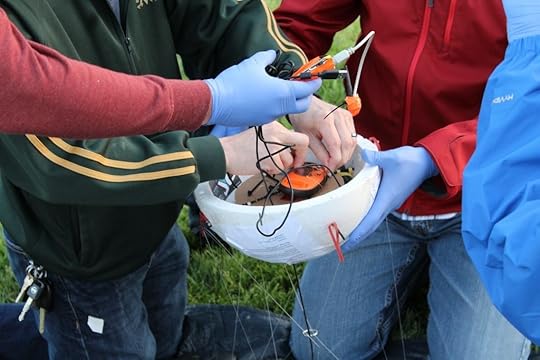 Top half of payload. Contains SPOT GPS tracker, APRS transmitter, and an upward facing camera.
Top half of payload. Contains SPOT GPS tracker, APRS transmitter, and an upward facing camera. Because the weather balloon bursts at some altitude, causing the payload to fall back to Earth, a parachute is attached just above the payload. Also, for safety, a radar reflector is attached just below the payload. The payload, parachute, and radar reflector were attached to a weather balloon with cord rated to break at a specific tension as dictated by the FAA. Rather than use a complicated system of gimbals to stabilize the payload, we instead used a system designed in 1912 by French engineer and WWI balloon pilot, Pierre Picavet. The system is simply called a Picavet Suspension, and is commonly used in taking aerial photographs from kites. For this project, the Picavet Suspension was made of a rigid cross of PVC pipe and monofilament fishing line looped through rings (see image below). As the cross tilts, the string slides through the loops allowing the payload to remain upright. You can see a video of the suspension in action and read more about it here.
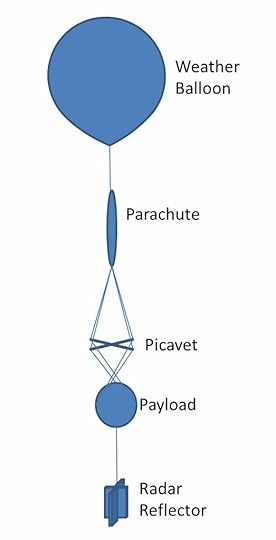 Above the payload, a parachute is attached to control the descent of the balloon. For safety, a radar reflector is attached below the payload.
Above the payload, a parachute is attached to control the descent of the balloon. For safety, a radar reflector is attached below the payload.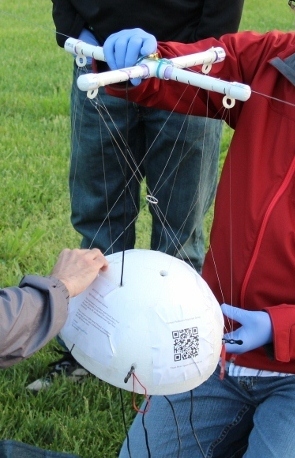 A close up of the Picavet suspension made from PVC pipe, plastic and metal rings, and monofilament fishing line.
A close up of the Picavet suspension made from PVC pipe, plastic and metal rings, and monofilament fishing line.The launch took place on April 21, 2015 from RayLen Vineyards in Mocksville, NC (just west of Winston-Salem) at 7:55am. Below are images showing preparations prior to the launch.
[image error]
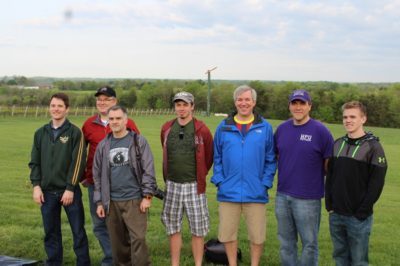 [image error]
[image error]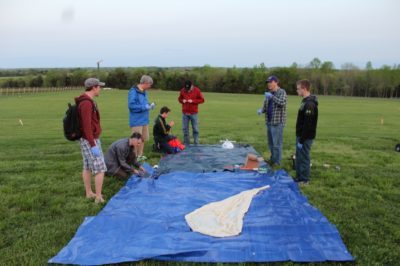 [image error]
[image error] [image error]
[image error]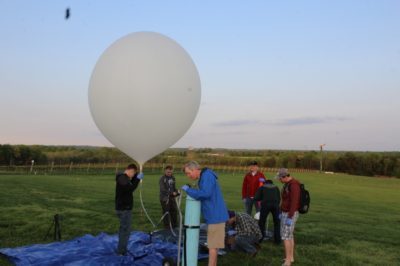 [image error]
[image error] [image error]
[image error] [image error]
[image error]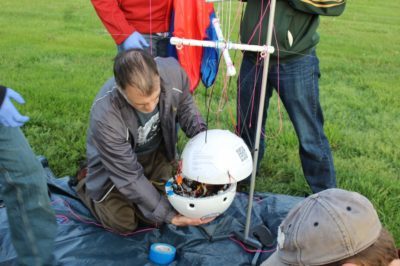 [image error]
[image error] [image error]
[image error]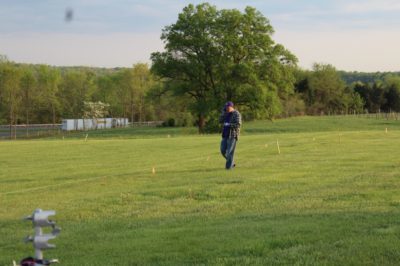 548 false false true false true true false auto false ease-in-out 300 false 0 true false Previous (Left arrow key) Next (Right arrow key) %curr% of %total%
548 false false true false true true false auto false ease-in-out 300 false 0 true false Previous (Left arrow key) Next (Right arrow key) %curr% of %total%A video of the launch itself. . .
The launch from the perspective of the payload. Prepare to get dizzy!
As the balloon ascends, the atmospheric pressure outside the balloon decreases. This causes the balloon to expand until it eventually ruptures. The series of images below was taken from an upward facing camera and shows the balloon at various altitudes along its ascent. Note the change in size.
[image error]
 [image error]
[image error]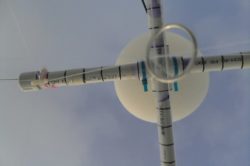 [image error]
[image error]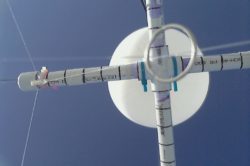 [image error]
[image error]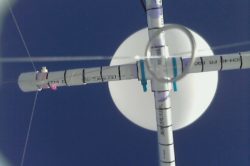 [image error]
[image error]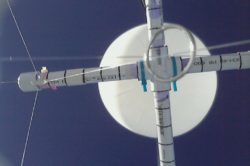 [image error]
[image error]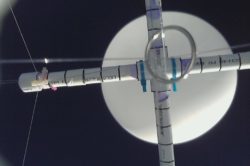 [image error]
[image error]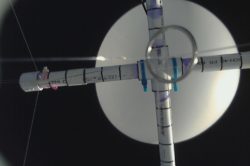 [image error]
[image error]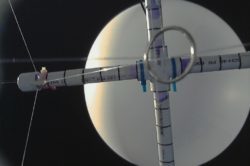 [image error]
[image error]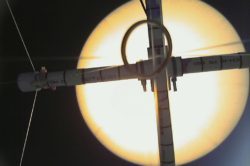 [image error]
[image error]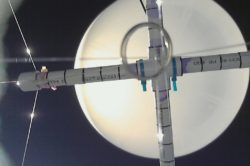 [image error]
[image error]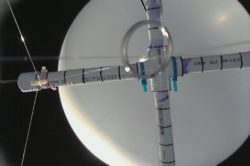 [image error]
[image error]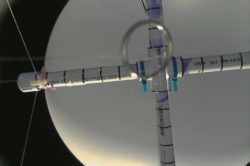 327 false false true false true true false auto false ease-in-out 300 false 0 true false Previous (Left arrow key) Next (Right arrow key) %curr% of %total%
327 false false true false true true false auto false ease-in-out 300 false 0 true false Previous (Left arrow key) Next (Right arrow key) %curr% of %total%When the balloon finally ruptures, the payload slows to stop and then tumbles and falls. The series of images below were again taken from the upward facing camera and shows the balloon at various altitudes along its descent. Unfortunately, we missed the exact moment of rupture, so the first image is just afterward. The next couple of images show significant distortion of the Picavet cross, indicating abrupt rotation. Eventually, the parachute opens, stabilizing and slowing the descent. In the final image, the payload has settled in a very short tree, which made recovery easier than anticipated. The parachute as well as the radar reflector (silver object near the top center of the final image) are easily identified.
[image error]
 [image error]
[image error]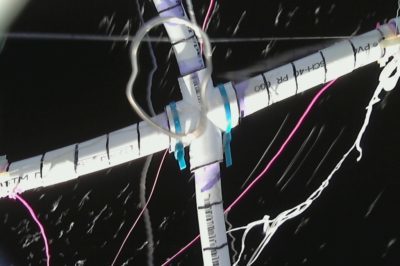 [image error]
[image error] [image error]
[image error]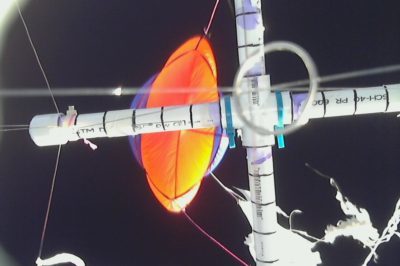 [image error]
[image error]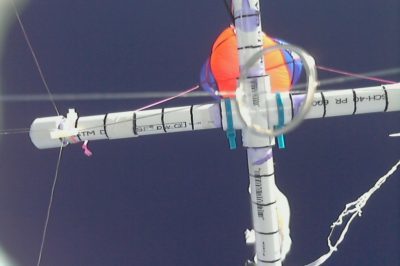 [image error]
[image error]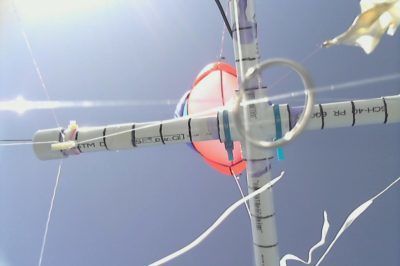 [image error]
[image error] [image error]
[image error] [image error]
[image error]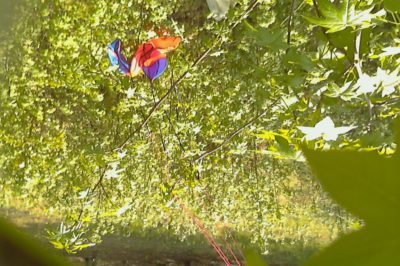 335 false false true false true true false auto false ease-in-out 300 false 0 true false Previous (Left arrow key) Next (Right arrow key) %curr% of %total%
335 false false true false true true false auto false ease-in-out 300 false 0 true false Previous (Left arrow key) Next (Right arrow key) %curr% of %total%The payload landed at 9:39am in Hurdle Mills, North Carolina, roughly 100 miles East Northeast of the launch site. An analysis of the pressure sensor data revealed that the maximum altitude reached by the balloon had been about 80,000 ft above sea level. Below are plots of the pressure sensor data, as well as plots of the altitude and ascent or descent rate derived from the pressure data. The stated operating range of the SparkFun BMP180 pressure sensor gives the lowest calibrated pressure as 30,000 Pa. This corresponds to an altitude of about 30,000 ft. above sea level. Therefore, it is not clear how accurate the pressure data was after the balloon passed 30,000 ft. The manufacturer of the weather balloon claims a burst altitude of between 95,000 ft and 105,000 ft, although this depends on the payload weight and level of inflation. Given this, together with the fact that the balloon continued to ascend for about 45 minutes after passing 30,000 ft makes it plausible that the maximum altitude could have been in the neighborhood of 80,000 ft or even higher.
[image error]
 [image error]
[image error]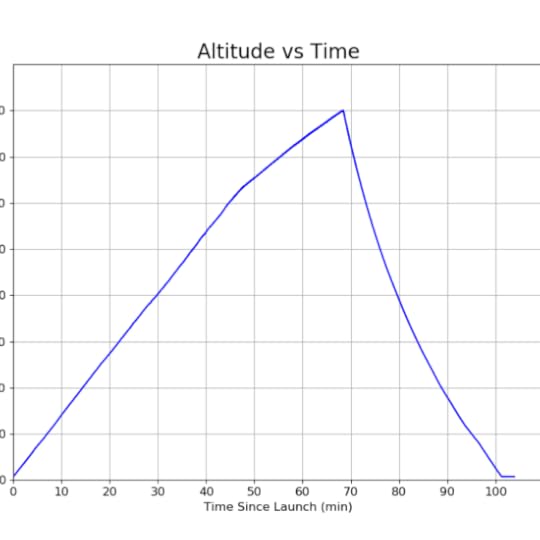 [image error]
[image error] [image error]
[image error] 607 false false true false true true false auto false ease-in-out 300 false 0 true false Previous (Left arrow key) Next (Right arrow key) %curr% of %total%
607 false false true false true true false auto false ease-in-out 300 false 0 true false Previous (Left arrow key) Next (Right arrow key) %curr% of %total%The post High-Altitude Balloon appeared first on Martin A. DeWitt.



